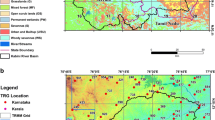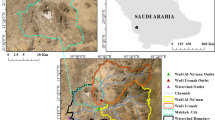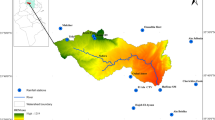Abstract
Flood risk management studies require reliable estimates of extreme precipitation at high spatial–temporal distribution to force hydrologic models. Recently, Remote Sensing Rainfall Products (RRPs) have gained significant importance in the field of hydrometeorology, but their applicability in urban hydrologic predictions remains uncertain. The current study evaluates the accuracy of RRPs in comparison with observed rainfall and the significance of space–time representation of rain in simulating single and bimodal flood hydrographs. The study is conducted for the Adyar river basin, a rapidly developing urban area in Chennai experiencing frequent floods. Sub-daily rainfall retrievals from Integrated Multi-satellite Retrievals for Global Precipitation Measurement version 6 final run product (IMERG GPM), the near-real-time Global Satellite Mapping of Precipitation (GSMaP_NRT) version 6, GSMaP gauge adjusted (GSMaP_Gauge), Precipitation Dynamic Infrared Rain Rate near real-time (PDIR-Now) and Doppler Weather Radar (DWR) are the Remote sensing Rainfall products (RRPs) selected in the present study. Continuous and categorical statistical indices are selected to evaluate the performance of satellite rainfall estimates for the period from 2001 to 2015. Then the hydrologic utility of RRPs is conducted using the Hydrologic Engineering Center Hydrologic Modeling System (HEC-HMS) model for five extreme precipitation events. The RRPs simulated the rising and recession portion of flood hydrographs accurately with a bias in peak discharge. Then, two approaches are selected to further improve the flood hydrograph simulations; 1) Hydrologic model simulations after disaggregating the daily station data to sub-daily scale using time characteristics of RRPs, 2) Hydrologic simulations after bias adjusting the RRPs with station data. The study finds substantial improvements in model results in the two approaches. The disaggregation approach using satellite rainfall estimates has overcome the insufficiency of sub-daily rainfall observations. The bias adjusted radar rainfall data is found as best performing for the flood hydrograph simulations.








Similar content being viewed by others
Availability of Data and Materials
Not applicable.
References
Besic N, Gehring J, Praz C, Figueras i Ventura J, Grazioli J, Gabella M, Germann U, Berne A (2018) Unraveling hydrometeor mixtures in polarimetric radar measurements. Atmos Meas Tech 11:4847–4866. https://doi.org/10.5194/amt-11-4847-2018
Chaudhary S, Dhanya CT (2020) Decision tree-based reduction of bias in monthly IMERG satellite precipitation dataset over India. H2Open J 3:236–255. https://doi.org/10.2166/h2oj.2020.124
Chen H, Yu R, Shen Y (2016) A new method to compare hourly rainfall between station observations and satellite products over central-eastern China. J Meteorol Res 30:737–757. https://doi.org/10.1007/s13351-016-6002-5
Cho Y (2020) Application of NEXRAD radar-based quantitative precipitation estimations for hydrologic simulation using arcpy and HEC software. Water (Switzerland) 12. https://doi.org/10.3390/w12010273
Criss RE, Winston WE (2008) Do Nash values have value? Discussion and alternate proposals. Hydrol Process 22:2723–2725. https://doi.org/10.1002/hyp.7072
Cristiano E, ten Veldhuis MC, Wright DB, Smith JA, van de Giesen N (2019) The influence of rainfall and catchment critical scales on urban hydrological response sensitivity. Water Resour Res 55:3375–3390. https://doi.org/10.1029/2018WR024143
Moriasi DN, Arnold JG, Van Liew MW, Bingner RL, Harmel RD, Veith TL (2007) Model evaluation guidelines for systematic quantification of accuracy in watershed simulations. Trans ASABE 50:885–900. https://doi.org/10.13031/2013.23153
Du J, Cheng L, Zhang Q, Yang Y, Xu W (2019) Different flooding behaviors due to varied urbanization levels within river basin: A case study from the Xiang River Basin, China. Int J Disaster Risk Sci 10:89–102. https://doi.org/10.1007/s13753-018-0195-4
Fang X, Shao A, Yue X, Liu W (2018) Statistics of the Z-R relationship for strong convective weather over the Yangtze-Huaihe River basin and its application to radar reflectivity data assimilation for a heavy rain event. J Meteorol Res 32:598–611. https://doi.org/10.1007/s13351-018-7163-1
Ferreira PMDL, Paz ARD, Bravo JM (2020) Objective functions used as performance metrics for hydrological models: state-of-the-art and critical analysis. Rbrh 25. https://doi.org/10.1590/2318-0331.252020190155
Ghimire U, Akhtar T, Shrestha NK, Paul PK, Schürz C, Srinivasan R, Daggupati P (2022) A long-term global comparison of IMERG and CFSR with surface precipitation stations. Water Resour Manag 36:5695–5709. https://doi.org/10.1007/s11269-022-03328-5
Gilewski P, Nawalany M (2018) Inter-comparison of Rain-Gauge, Radar, and Satellite (IMERG GPM) precipitation estimates performance for rainfall-runoff modeling in a mountainous catchment in Poland. Water (Switzerland) 10:1–23. https://doi.org/10.3390/w10111665
Guilloteau C, Foufoula-Georgiou E, Kirstetter P, Tan J, Huffman GJ (2021) How well do multi-satellite products capture the space-time dynamics of precipitation? Part I: five products assessed via a wavenumber-frequency decomposition. J Hydrometeorol. https://doi.org/10.1175/jhm-d-21-0075.1
Gupta HV, Kling H, Yilmaz KK, Martinez GF (2009) Decomposition of the mean squared error and NSE performance criteria: Implications for improving hydrological modelling. J Hydrol 377:80–91. https://doi.org/10.1016/j.jhydrol.2009.08.003
Hou J, Wang N, Guo K, Li D, Jing H, Wang T, Hinkelmann R (2020) Effects of the temporal resolution of storm data on numerical simulations of urban flood inundation. J Hydrol 589:125100. https://doi.org/10.1016/j.jhydrol.2020.125100
Junyent F, Chandrasekar V (2009) Theory and characterization of weather radar networks. J Atmos Ocean Technol 26:474–491. https://doi.org/10.1175/2008JTECHA1099.1
Kubota T, Hashizume H, Shige S, Okamoto K, Aonashi K, Takahashi N, Ushio T, Kachi M (2006) Global precipitation map using satelliteborne microwave radiometers by the GSMaP project: Production and validation. Int Geosci Remote Sens Symp 45:2584–2587. https://doi.org/10.1109/IGARSS.2006.668
Lengfeld K, Kirstetter PE, Fowler HJ, Yu J, Becker A, Flamig Z, Gourley J (2020) Use of radar data for characterizing extreme precipitation at fine scales and short durations. Environ Res Lett 15. https://doi.org/10.1088/1748-9326/ab98b4
Macharia D, Fankhauser K, Selker JS, Neff JC, Thomas EA (2022) Validation and intercomparison of satellite-based rainfall products over Africa with TAHMO in situ rainfall observations. J Hydrometeorol 23:1131–1154. https://doi.org/10.1175/JHM-D-21-0161.1
Moazamigoodarzi S (2020) Evaluation and bias correction of remotely sensed precipitation products across Canada. Electronic Thesis and Dissertation Repository 7167. https://ir.lib.uwo.ca/etd/7167
Moriasi DN, Gitau MW, Pai N, Daggupati P (2015) Hydrologic and water quality models: Performance measures and evaluation criteria. Trans ASABE 58:1763–1785. https://doi.org/10.13031/trans.58.10715
Narasimhan B, Bhallamudi SM, Mondal A, Ghosh S, Mujumdar P (2016) Chennai floods 2015: A rapid assessment. Interdisciplinary Centre for Water Research, Indian Institute of Science, Bangalore. http://www.icwar.iisc.ac.in/wp-content/uploads/2016/06/Chennai-Floods-Rapid-Assessment-Report.pdf (Accessed on 01 Jan 2023)
Navarro A, García-Ortega E, Merino A, Sánchez JL, Kummerow C, Tapiador FJ (2019) Assessment of IMERG precipitation estimates over Europe. Remote Sens 11. https://doi.org/10.3390/rs11212470
Nerini D, Zulkafli Z, Wang LP, Onof C, Buytaert W, Lavado-Casimiro W, Guyot JL (2015) A comparative analysis of TRMM-rain gauge data merging techniques at the daily time scale for distributed rainfall-runoff modeling applications. J Hydrometeorol 16:2153–2168. https://doi.org/10.1175/JHM-D-14-0197.1
Nguyen P, Shearer EJ, Ombadi M, Gorooh VA, Hsu K, Sorooshian S, Logan WS, Ralph M (2020) PERSIANN dynamic infrared-rain rate model (PDIR) for high-resolution, real-time satellite precipitation estimation. Bull Am Meteorol Soc 101:E286–E302. https://doi.org/10.1175/BAMS-D-19-0118.1
Pradhan A, Indu J (2021) Assessment of SM2RAIN derived and IMERG based precipitation products for hydrological simulation. J Hydrol 127191. https://doi.org/10.1016/j.jhydrol.2021.127191
Pradhan RK, Markonis Y, Vargas Godoy MR, Villalba-Pradas A, Andreadis KM, Nikolopoulos EI, Papalexiou SM, Rahim A, Tapiador FJ, Hanel M (2022) Review of GPM IMERG performance: A global perspective. Remote Sens Environ 268:112754. https://doi.org/10.1016/j.rse.2021.112754
Prakash S, Mitra AK, Momin IM, Pai DS, Rajagopal EN, Basu S (2015) Comparison of TMPA-3B42 versions 6 and 7 precipitation products with gauge-based data over India for the southwest monsoon period. J Hydrometeorol 16:346–362. https://doi.org/10.1175/JHM-D-14-0024.1
Ramasamy C, Ramanathan S, Balasubramanian TN, Raghupati N, Natarajan S, Devasenapathy P, Natarajan N (2004) Alternative cropping pattern in Tamilnadu.Tamilnadu Agricultral University (TNAU), Coimbatore
Retalis A, Katsanos D, Tymvios F, Michaelides S (2020) Comparison of GPM imerg and TRMM 3B43 products over Cyprus. Remote Sens 12:1–18. https://doi.org/10.3390/rs12193212
Shakti PC, Nakatani T, Misumi R (2019) The role of the spatial distribution of radar rainfall on hydrological modeling for an urbanized river basin in Japan. Water 11:6–8. https://doi.org/10.3390/w11081703
Skofronick-Jackson G, Kirschbaum D, Petersen W, Huffman G, Kidd C, Stocker E, Kakar R (2018) The Global Precipitation Measurement (GPM) mission’s scientific achievements and societal contributions: reviewing four years of advanced rain and snow observations. Q J R Meteorol Soc 144:27–48. https://doi.org/10.1002/qj.3313
Smitha PS, Narasimhan B, Sudheer KP, Annamalai H (2018) An improved bias correction method of daily rainfall data using a sliding window technique for climate change impact assessment. J Hydrol 556:100–118. https://doi.org/10.1016/j.jhydrol.2017.11.010
Sun W, Sun Y, Li X, Wang T, Wang Y, Qiu Q, Deng Z (2018) Evaluation and correction of GPM IMERG precipitation products over the capital circle in Northeast China at multiple spatiotemporal scales. Adv Meteorol. https://doi.org/10.1155/2018/4714173
Uijlenhoet R (2001) Raindrop size distributions and radar reflectivity–rain rate relationships for radar hydrology. Hydrol Earth Syst Sci 5:615–628. https://doi.org/10.5194/hess-5-615-2001
United Nations (2018) The World’s Cities in 2018—Data Booklet (ST/ESA/ SER.A/417). United Nations, Department of Economic and Social Affairs, Population Division
Wang X, Ding Y, Zhao C, Wang J (2019) Similarities and improvements of GPM IMERG upon TRMM 3B42 precipitation product under complex topographic and climatic conditions over Hexi region, Northeastern Tibetan Plateau. Atmos Res 218:347–363. https://doi.org/10.1016/j.atmosres.2018.12.011
Willmott CJ (1981) On the validation of models. Phys Geogr 2:184–194. https://doi.org/10.1080/02723646.1981.10642213
Yin J, Guo S, Gu L, Zeng Z, Liu D, Chen J, Shen Y, Xu CY (2021) Blending multi-satellite, atmospheric reanalysis and gauge precipitation products to facilitate hydrological modelling. J Hydrol 593:125878. https://doi.org/10.1016/j.jhydrol.2020.125878
Zeng Q, Chen H, Xu CY, Jie MX, Chen J, Guo SL, Liu J (2018) The effect of rain gauge density and distribution on runoff simulation using a lumped hydrological modelling approach. J Hydrol 563:106–122. https://doi.org/10.1016/j.jhydrol.2018.05.058
Acknowledgements
We would like to acknowledge and thank the scholarship provided by the Ministry of Human Resource Development (MHRD), Government of India.
Funding
This research received funding from Department of Science and Technology, Ministry of Science and Technology, Grant/Award Number: DST/CCP/CoE/141/2018(G);
Author information
Authors and Affiliations
Contributions
Balaji Narasimhan, P. Yaswanth, and V.M Bindhu contributed to the study conception and design. V.M Bindhu and P. Yaswanth conducted the hydrologic model calibration studies. B. Arul Malar Kannan from the IMD department provided the weather radar precipitation estimates. Material preparation, satellite rainfall analysis and hydrological simulations were performed by P Yaswanth. The first draft of the manuscript was prepared by P. Yaswanth and all authors commented on previous versions of the manuscript. Balaji Narasimhan, P. Yaswanth approved the final manuscript.
Corresponding author
Ethics declarations
Ethical Approval
Not applicable.
Consent to Participate
Not applicable.
Consent to Publish
The authors declare their consent of the publication of this manuscript by “Water Resources Management” journal.
Competing Interests
The authors declare no conflict of interest.
Additional information
Publisher's Note
Springer Nature remains neutral with regard to jurisdictional claims in published maps and institutional affiliations.
Rights and permissions
Springer Nature or its licensor (e.g. a society or other partner) holds exclusive rights to this article under a publishing agreement with the author(s) or other rightsholder(s); author self-archiving of the accepted manuscript version of this article is solely governed by the terms of such publishing agreement and applicable law.
About this article
Cite this article
Yaswanth, P., Kannan, B.A.M., Bindhu, V.M. et al. Evaluation of Remote Sensing Rainfall Products, Bias Correction and Temporal Disaggregation Approaches, for Improved Accuracy in Hydrologic Simulations. Water Resour Manage 37, 3069–3092 (2023). https://doi.org/10.1007/s11269-023-03486-0
Received:
Accepted:
Published:
Issue Date:
DOI: https://doi.org/10.1007/s11269-023-03486-0




